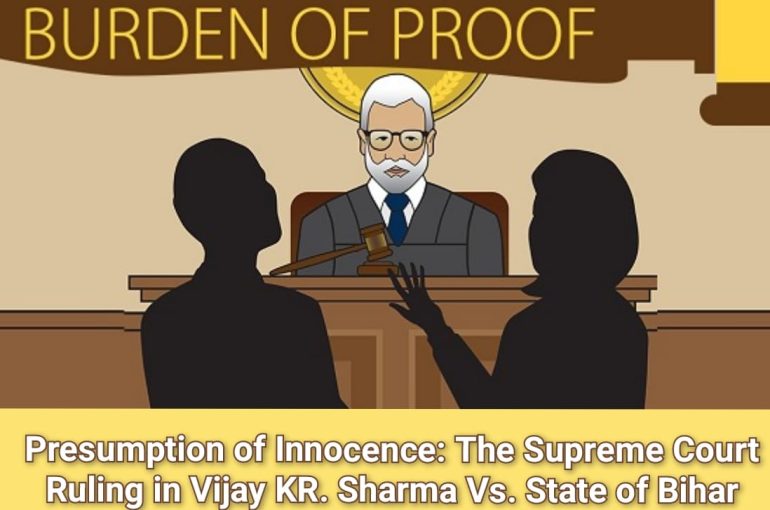Presumption of Innocence: The Supreme Court Ruling in Vijay KR. Sharma Vs. State of Bihar
Introduction
Supreme Court (Division Bench) ruling in Vijay KR. Sharma Vs. State of Bihar (CRL. A NO. 1031 OF 2015) highlights the presumption of innocence and the burden of proof on the Prosecution in criminal law.
Facts
1) On August 30, 1985, Neelam was found dead in Simaltalla, PS Sikandra, District Munger, Bihar. The circumstances surrounding her death were brought to light by her brother-in-law, Ramanand Singh (PW18), who reported that she was abducted by seven individuals from their home around 10:00 PM. Following this report, an FIR (No. 127 of 1985) was lodged at PS Sikandra, leading to an investigation and the eventual filing of a chargesheet against the Accused.
2) The Trial Court charged all seven Accused with multiple offences under the Indian Penal Code, including murder (Section 302) and kidnapping (Section 364). On June 5, 1992, the Court convicted five of the Accused (Nos. 1-5) of the charges related to murder and kidnapping, while two (Nos. 6 and 7) were acquitted. This decision prompted appeals from both the convicts and the State, challenging the acquittals.
3) The background of the case reveals a complex web of familial disputes over property. Neelam was the daughter of Jang Bahadur Singh and resided in his house with her husband, Ashok Kumar, and her brother-in-law, Ramanand Singh. Issues had escalated regarding the inheritance of the property following Jang Bahadur Singh’s death. The Accused were motivated by a desire to gain control over the estate amid ongoing legal battles concerning a will, leading to a tragic confrontation.
4) On the night of the abduction, as Ramanand and others sat outside, the armed attacker entered the house, threatening and assaulting Ramanand before forcibly taking Neelam and stealing her belongings. Witnesses observed the horrifying events but refrained from intervening due to the threats posed by the attackers. This case not only highlights the tragic outcomes of inheritance disputes but also reflects on the broader implications of violence stemming from familial conflicts.
Trial Court
1) The Trial Court acquitted Accused A-6 and A-7 due to insufficient evidence linking them to the crime. It noted that the motive for Neelam’s abduction and murder did not apply to them, as there was no established personal interest in the ongoing litigation. A-6 was not named in the FIR, and testimony did not implicate either A-6 or A-7 in the assault.
2) In contrast, the Trial Court convicted A-1 to A-5 under Sections 302/34 and 364/34 of the Indian Penal Code, relying on the testimonies of key witnesses, including the informant (PW18) and other eyewitnesses (PW2, PW4, and PW5). The Court found the motive rooted in a property dispute following the deceased’s father’s death. It also considered circumstantial evidence from additional witnesses, allowing it to establish a clear connection between A-1 to A-5 and the charges against them.
High Court
1) The High Court reviewed the case of Neelam’s abduction and murder, conducting a fresh analysis of the evidence. The Court confirmed her residence at the house from which she was abducted based on testimonies from her maternal uncle (PW7), brother-in-law (PW18), and the investigating officer (PW21). However, it dismissed the lack of corroborating statements from other independent witnesses, relying instead on the discovery of cosmetics as evidence of Neelam’s presence.
2) The High Court excluded the testimony of PW5 due to doubts about his location during the incident, which strengthened the case against the main Accused (A-1 to A-5). The Court upheld their convictions for murder and abduction based on consistent testimonies and circumstantial evidence.
3) In a significant turn, the Court overturned the Trial Court’s acquittal of A-6 and A-7, asserting that their conviction was supported by the consistent accounts of other witnesses. The defence argued that these two Accused lacked motive and questioned the reliability of the witnesses, particularly regarding the timeline of the victim’s death.
4) The State contended that the absence of independent witnesses did not weaken their case, asserting that the High Court’s re-evaluation of the evidence was justified. Overall, the judgement underscores the complexities of witness credibility and the careful consideration required in serious criminal cases.
5) The High Court reviewed the case, focusing on the sustainability of the guilt findings against the Appellants and the appropriateness of reversing their acquittal. The case centred on charges of abduction (Section 364 IPC) and murder (Section 302 IPC), with the prosecution relying on direct oral evidence for the abduction and circumstantial evidence for the murder.
Supreme Court
1) The Supreme Court addressed the High Court’s reversal of acquittal for A-6 and A-7. The Court clarified that while the High Court had the authority to appreciate evidence in its appellate capacity, a higher threshold is necessary to overturn a finding of acquittal. This presumption of innocence becomes more solidified with an acquittal by the Trial Court, meaning that mere alternate interpretations of evidence are insufficient for reversal.
2) The Court emphasised that any appellate court must consider the reasoning behind the Trial Court’s acquittal, specifically identifying any illegality or perversity in the original findings. It noted that the High Court failed to provide such justification, instead offering a cursory review.
3) The Supreme Court cited established principles regarding appeals against acquittals, underlining that an appellate court should be reluctant to interfere if two reasonable views arise from the evidence. In this case, the Prosecution’s case was fraught with significant doubts, particularly regarding the abduction and the circumstantial evidence related to the murder. The lack of direct evidence linking the Accused to the crime further weakened the Prosecution’s stance.
4) Regarding motive, the Court noted that it could work both ways, as both the Accused and the eyewitnesses were intertwined in familial and property disputes, complicating any conclusions based on motive alone.
5) Ultimately, the Prosecution failed to meet the burden of proof beyond a reasonable doubt, leading to irreconcilable doubts that undermined its case. As a result, the Supreme Court acquitted all seven Accused persons of the charges and set aside the judgments of both the Trial Court and the High Court regarding the convictions. The Appellants were directed to be released forthwith if in custody.
The Appeals were disposed of accordingly, with no order as to costs.
Conclusion
The Supreme Court’s in this recent judgement underlines the critical importance of maintaining the presumption of innocence and the high burden of proof required in criminal cases. The Court highlighted that the High Court’s reversal of the Trial Court’s acquittal of A-6 and A-7 lacked sufficient justification and did not adequately address the legal principles governing appeals against acquittals.
By scrutinising the Prosecution’s case, which was riddled with doubts and reliant on circumstantial evidence, the Supreme Court determined that it failed to prove the guilt of the Accused beyond a reasonable doubt. This ruling not only reinforces the need for a meticulous evaluation of evidence in serious criminal matters but also illustrates the complexities surrounding familial disputes and their implications in legal proceedings. Ultimately, all seven Accused were acquitted, emphasising the necessity of a robust evidentiary foundation in securing convictions.
Shikha
Associate
The Indian Lawyer & Allied Services





































Leave a Reply